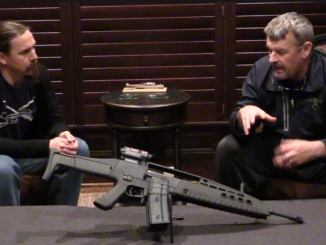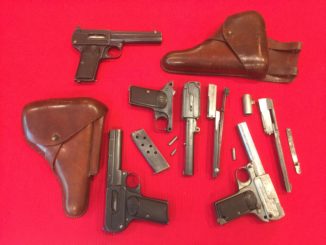The German military tested several designs of silencer for the MP40 submachine gun during late World War Two. Designated the L4x series, they were made by the Arado and Opel-Schneider companies. This example is an Arado L41, designed to use the sort of heavy rubber baffles as the Soviet Bramit pattern. The L41 used two such baffles and a single large expansion chamber, giving it a rather short overall length.
Instead of using a clamp-on attachment like many of the adopted rifle silencers, the L41 is threaded to the MP40 muzzle. However, the MP40 muzzle threads were made without a significant tolerance requirement (as they were only designed for use with blank-firing adapters) and so the exit diameter of these suppressors had to be made substantially larger than 9mm in order to prevent bullet strikes. Ultimately no MP40 silencers were formally adopted.




“(…)Arado(…)”
Wait… is that Arado Flugzeugwerke, known for building Blitz quick bomber
https://www.militaryfactory.com/aircraft/detail.php?aircraft_id=101
or some totally different entity using Arado name? If 1st how they get involved in development of utensils for infantry weapons?
Yes it is Daweo. Apparently they had a section working on suppressor development as they developed multiple models. They made 2 versiona of the L41 for the MP40. The also made multiple versions for the K98. The first of which was a straight copy of the Russian “Brammit” suppressor which was designated L23. This version was later revised to use the grenade launcher type locking system designated L27.
A possible reason for letting Arado develop suppressors was possibly because of the experience they had with metal working? Or because they had extra engineers?
In German documents of “Sonderkommission Infanteriewaffen” I have repeatedly seen the name “Schneider-Opel” being used, but not Opel-Schneider.
From these it also looks as if Arado had a branch in Eisfeld, Thuringia, which was involved in the silencers.
In episode 24 of the documentary series Hogans Heroes a silent airplane engine is featured. Perhaps this is why Arado was developing silenced firearms.
seems that some were issued I tried to paste a picture of one that seems to have been captured by the russians. couldn’t get it to paste
“(…)have been captured by the russians(…)”
This is not evidence that it was issued. It might be issued and therefore capture, but it might be also effect of sampling III Reich technology by Soviet Union following WW2 c.f. Operation Ossoawiachim https://de.wikipedia.org/wiki/Aktion_Ossawakim
Arado did small-arms development work for the same reason Rheinmetall did- when their main business was heavy artillery. Simply put, in Germany the corporations did whatever some Party official told them to.
The problem was that as with most primarily political setups, an official in charge of something often had no knowledge of the subject at hand.
Sometimes it worked. When Gerhard Degenkolb was put in charge of V2 (A4) rocket production, the experts at Peenemunde were horrified because his previous experience was in building railway locomotives.
As it turned out, he was the right man for the job; he knew nothing of rockets, and admitted it, but he was as near to being an expert in mass production as Germany had at the time.
He said that as far as he could tell, building three A4s was the equivalent in production terms of building one locomotive.
In the end he built about 6,000 rockets in less than one year, over half of which were fired at London. So he must have been doing something right.
clear ether
eon
Production of V2 rockets was economic catastrophe, whole program cost more then Manhattan project, and strategic or tactical gain through it was negligible.
More people died as “slave” workers building it, then in London or UK where rockets fell.
Idk about locomotives, but it was mentioned before that 1 cost something like 2 Tiger tanks, or even more.
1 V2 rocket cost about 10000 RM (Reichsmarks).
1 He111 medium bomber cost about 50000 RM.
The average “life” of an He111 over London was about 3 missions before it was shot down.
An He111 carried a 2000kg bomb load. A V2 had a 1000kg warhead package.
So buying 5 V2s for the cost of 1 He111 delivered 5 metric tons of ordnance in five “one shot” missions while the He111 delivered 6 metric tons before AAA or the RAF destroyed it. (V2 failure rate was only 14%, BTW.)
By comparison, a single Fi103 aka V1 “buzz bomb” cost 2000 RM, and also carried a 1000 kg warhead. So they could have bought five V1s for the cost of one V2, or twenty-five for the cost of one He111. (V1 failure rate after launch was only 5%; it was much simpler than a V2 or an HE111, so there was a lot less to go wrong.)
That sounds more cost-effective until you consider that due to AAA and the RAF, only 30% of V1s reached their targets.
So the cost of one He111 in V1s delivered about 7 metric tons of HE to London when everything was factored in.
There wasn’t much to choose between the three, but the V2;
1. Did not risk the lives of aircrews.
2. Was essentially uninterceptible.
3. Did not require fixed launching sites or airfields.
4. Ran on liquid oxygen (fixed from atmosphere) and 40%/60% water/alcohol (the alcohol supplied by- don’t laugh- potatoes), and did not require gasoline (needed by both the He111 and the V1).
In short, as counter-intuitive as it sounds, the V2 was the most overall cost-effective way to deliver high explosives to London.
On the other hand, if the RM expended on V2s had been spent on AA missiles or Me262 jets to stop the USAAF and RAF bombers, there’s a good chance the war in Europe might have lasted into late 1945 or even early 1946, with Germany trying for another “Armistice”.
The more likely result would have been the first A-bomb out of Los Alamos being dropped on Berlin instead of Hiroshima.
Any way you crunch the numbers, Germany probably should have been thankful for the V2.
See;
Longmate, Norman. Hitler’s Rockets; The Story of the V2. London; Frontline Books, 2009.
Hill, Air Chief Marshal Sir Roderic. Air Operations by Air Defence of Great Britain and Fighter Command in Connection with the German Flying Bomb and Rocket Offensives, 1944-45. Supplement to the London Gazette, 19 Oct 1948. Commonly known as the Hill Report.
cheers
eon
“(…)V2(…)”
According to https://www.dora.de/de/geschichte/chronologie/konzentrationslager/verlagerung-raketenproduktion-kohnstein it was from beginning designed as Terrorwaffe which suggest it was optimized for maximal psychological factor, not necessarily to deliver maximal amount of explosive per Reichsmark.
“(…)gasoline (needed by both the He111 and the V1)(…)”
Both used gasoline, but latter or more precisely its’ engine – Argus As 014
http://powerplants.warbirdsresourcegroup.org/german_argus_as014.html
accepted low-grade gasoline alias low-octane gasoline
Eon, beautiful analysis!
Comparison to bombers and such makes sense somewhat only until you realise V2 isnt precision guided munition, and by accounts many of them landed in empty spaces in London, supposedly because of english intelligence reports ploy.
Even if it struck some residential building or area, it is not a factory (where it could do immensely more damage in destroying enemys production capacities), and again, strategic gain is minimal to nonexistent.
In the end you got a, like Daweo said, “terrorwaffe” that serves basicly solely as propaganda purpose for your own population (including having them to do something) as in “see were, fighting them back”.
But we have discussed all this many times before, connected to topic of germans resource and projects mismanagement…
However, its excellent to see some precise data and put it into context.
“(…)was mentioned before that 1 cost something like 2 Tiger tanks, or even more.(…)”
My cursory search revealed https://www.worldwar2facts.org/v2-rocket-facts.html
Unit cost: 100,000 RM January 1944, 50,000 RM March 1945
and https://tanks-encyclopedia.com/ww2/germany/panzer-vi_tiger.php
Each Tiger was calculated to cost RM250,800 (Reichsmarks) to build compared to just RM117,100 for a Panther and RM103,462 for a Panzer IV.
Therefore cost of 1 Tiger tank would be equivalent to 2.508 rocket (if you believe former price given to be true) or 5.016 rocket (if you believe latter price given to be true), though be warned that does not mean they can actually replace, as both weapons used different ingredients to be made.
Thanks for the correction!
In any case, I wanted to point out, which probably many history loving people do not realize, how these rockets were insanely expensive.
Thank you for that link. I knew of Soviet imprisonment of German engineers for technology work from articles about Soviet difficulties with stamped-steel rifles. But I didn’t know the scale of the overall program.
It’s about time anti-Americans stop pretending that their beloved Stalin didn’t exploit Nazi weaponsmakers. Of course he did, he would have been irresponsible not to investigate. Throwing said engineers into gulags does not somehow make it “better” than lionizing Werner Von Braun, because in both cases their treatment was entirely divorced from punishment for any war crimes.
Bear in mind that, though I believe in germans having some unclaimed, hidden input in soviet post ww2 small arms development, hard facts and documents are unfortunately still not found, and, given the relations west has now with russia, may never ever be found (they would destroy them), or at least for a very long time.
As for stampings, one must know that germans pursued very complex mild steel stampings, somewhat heavier, as opposed to AKs that have heat treated receiver (which has a potential for cracking) and thinner gauge. Germanys stamping technology from ww2 was top of the world at the time, compared to allies.